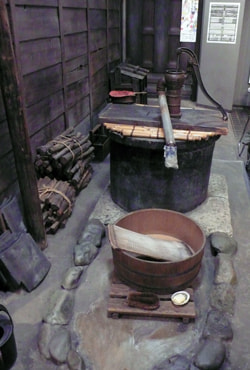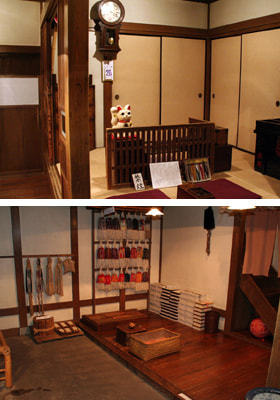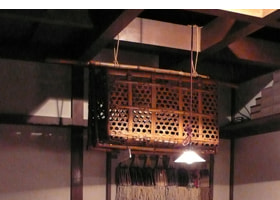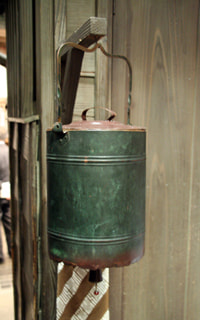There is a sign of people living here.

A hand pump, washbowl and washboard evoke nostalgic feelings.
The row house on the first floor
Q: This is a classic washboard, isn't it?
Ishii: The front side and back side of this washboard have different patterns. If you touch it, you can understand that you have to sit in an uncomfortable position when washing clothes. The side facing up is used for washing. The opposite side is used for rinsing. Bubbles run down towards the flanks of the washboard, so it is very functional. When you turn the washboard upside down, bubbles are kept. It is not appropriate if bubbles run down during the first stage of washing. The washboard was not used since early times because it was imported from the West. It is said that the washboard became widely used in the Taisho Period. For example, if this washboard is displayed in a showcase, the exhibition effect is entirely different. However, it is displayed in this way so that small children can also figure out the washing position and the difference between the front and back sides. I think the historical meanings and value of exhibits can be indicated through such experience. [continued in the lower column]

Ishii: For example, in the case of the Inari shrine, the first Horse Day festival, exhibited here, is its festival. Also, there is the bellows festival on November 8. It is a festival in which artisans who use a fire give thanks to their tools. During the festival, offerings are made to the Inari shrine. Also during the New Year's holiday, rice cakes are offered to the shrine. Season displays are put on the row house and shrine. Since each area in Taito City enters the festival season after the "Golden Week," exhibits related each festival are displayed during this season. Exhibits such as festival lanterns and flower decorations are displayed. Foreign visitors usually ask the meaning of the shrine crest of three comma-shaped figures in a circle which is depicted on lanterns. They must feel its religious quality.
When even an ordinary living space is reproduced, such a quality is filled. For example, a beckoning cat figure also represents a folk belief. The Seven Deities of Good Fortune and "Yaikagashi," or roasted sardine head, displayed at entrances, are other examples. Yaikagashi is displayed on the day before the beginning of spring as a talisman to ward off evils. The proverb "Iwashi no Atama mo Shinjin Kara," which means that even sardine heads have value to people who have faith in them, derived from this custom. The sardine head has a role to drive off contagious diseases.
This bamboo basket is a so-called emergency basket. This is a trace of Edo which was vulnerable to fires. Houses at that time were highly vulnerable to fires because they were densely built and made of wood and paper. When a fire broke out, important belongings were thrown into the basket and carried away. The basket is called "Yojin Kago."
Potted strawberry saxifrage is placed here, and potted Japanese rohdea is placed over the alley. These potted plants are also part of the exhibition. Foliage plants became popular and their prices rose sharply in the Meiji Period. Strawberry saxifrage was used as a folk medicine other than as a foliage plant. It was applied to cracked hands, slight illness or wound.
At the end of the alley, there is a lavatory. In the Taisho Period, a lavatory began to be installed in each house. The Taisho Period was an era of transformation of an excreta disposal system. In around 1921, it became impossible to dispose human excrement in neighboring farm villages. Human excrement was sold in ancient times. In the Edo Period, human excrement was highly priced and traded as a fertilizer. However, in the Taisho Period, the population increased rapidly, and the large amount of human excrement could not be disposed. Then, the government started to handle the disposal of human excrement. It began shortly before the Kanto Great Earthquake. [continued on the upper right column]
The merchant house on the first floor
Ishii: A beckoning cat figure is placed here. That is a counter, and this side is a workplace. Products were manufactured here, and transaction fees were calculated at the counter that was a sacred space where only an owner and head clerk of a merchant house could sit in. The figures of the beckoning cat and God of Wealth were popular ornaments in a merchant house. A big-headed dwarf figure was also placed in some cases. It was a good-luck token. The stairs leading to the second floor of this merchant house is a reproduction, so visitors can not actually go up the stairs. Most merchant houses facing streets were two-story buildings. In a merchant house of this size, there were six to seven servants. The second floor was used for a room of live-in servants. Only the entrance room of the merchant house is reproduced due to the structural limitation of this museum. [continued in the lower column]

This bamboo basket is a so-called emergency basket. This is a trace of Edo which was vulnerable to fires. Houses at that time were highly vulnerable to fires because they were densely built and made of wood and paper. When a fire broke out, important belongings were thrown into the basket and carried away. The basket is called "Yojin Kago."

This is a lavatory. Here is an opening for dipping up night soil. A big earthenware pot was placed under the cover. Human excrement was deposited in the pot, and then scooped up.
There is a well, but a faucet is not installed, so this "Tsuri Chozu-ki" was used for hand-washing. When people washed their hands, water filled in it ran down like a shower.[continued in the next page]


A hand pump, washbowl and washboard evoke nostalgic feelings.














